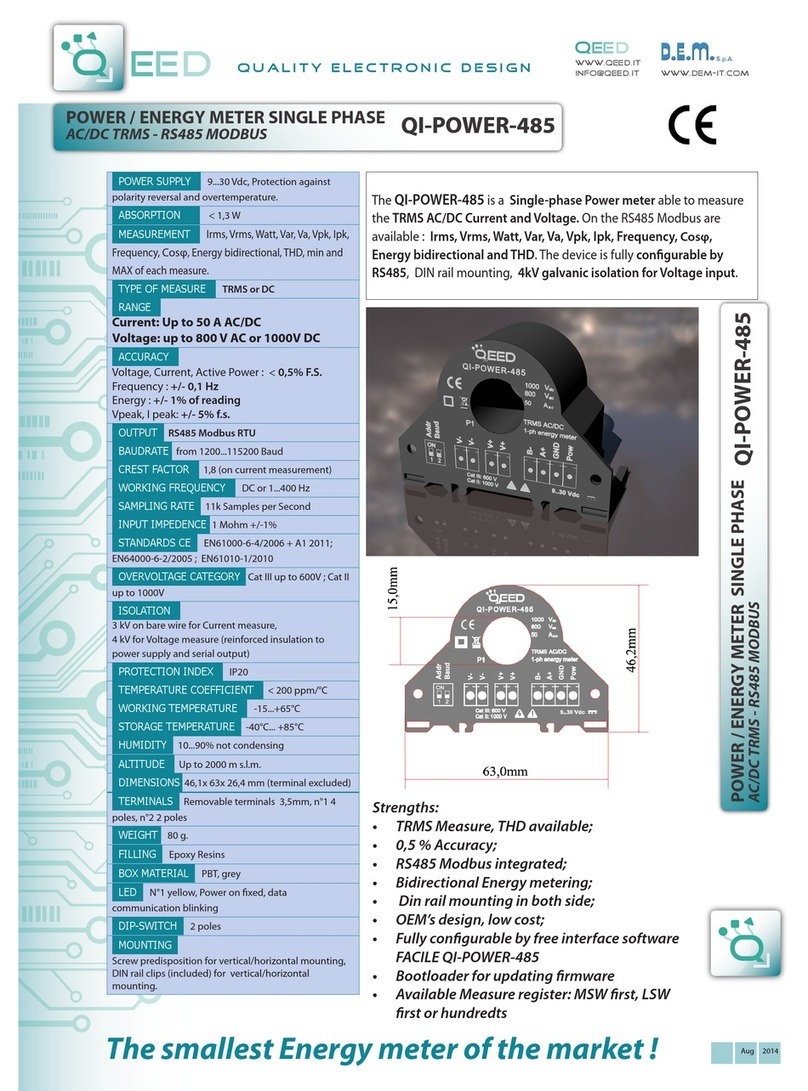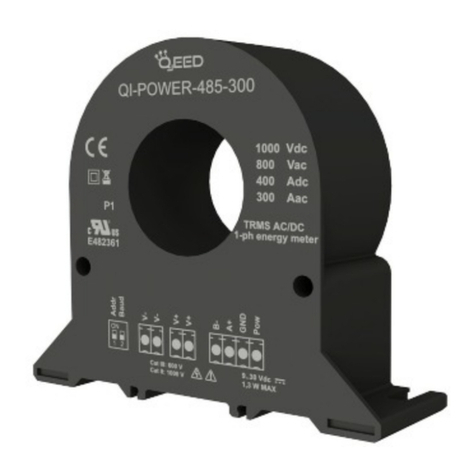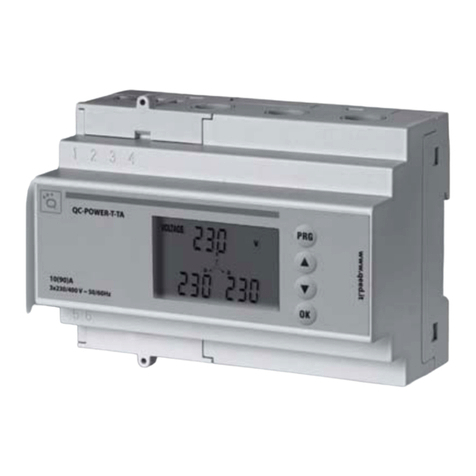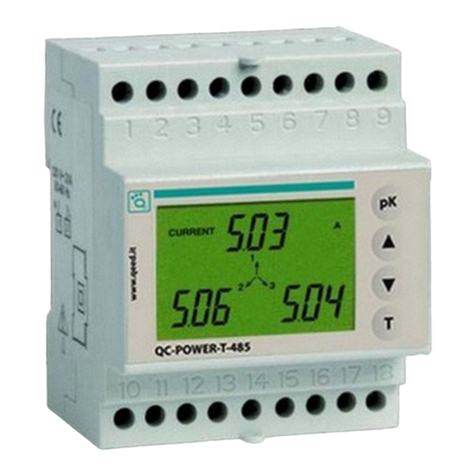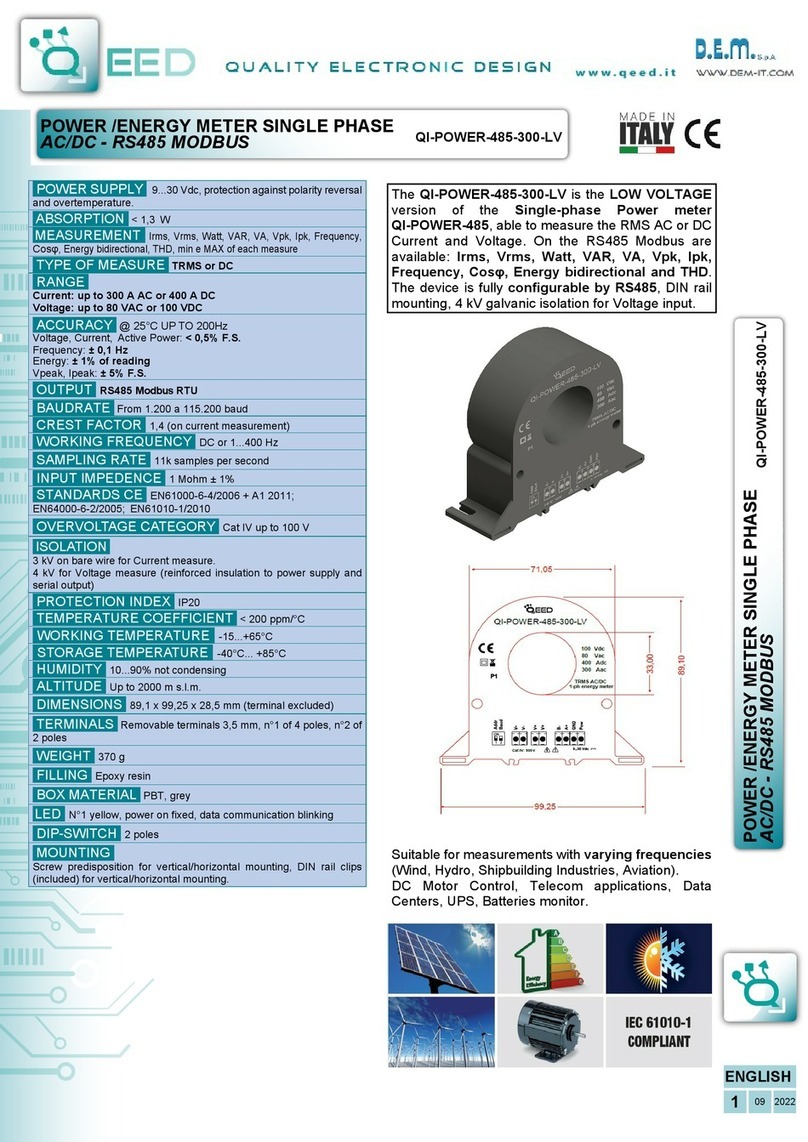ANALOG OUTPUT: the first drop-down menu in the upper left allow you
to associate the analog output to a single selectable Vrms, Irms, Active
Power, Reactive Power, Apparent Power, Cosφ, Frequency.The mode
of the analog output is VOLTAGE or CURRENT. The QA-POWER-M has the
ability to scale the input and output as required, then select the
measurement range of input (INPUT BEGIN SCALE and INPUT END SCALE)
to assign to the analog output signal (OUTPUT BEGIN SCALE and
OUTPUT END SCALE ). Depending on the choices made in the two menu
will change the units of measurement values in the input and output. If
you select the MANUAL CONTROL VIA MODBUS, you can manage the
module as if it were an AO (Analog Output), thus freeing the analog
output from the input selected. The analog output will be handled via
RS485 Modbus RTU (see register map).
DIGITAL OUTPUT:the digital output default set is NOT ACTIVE. If you
want to ACTIVE the digital output please set it on the right window.
ALLARM / FAIL ANALOG OUTPUT: it is possible to use the analog output
to control any supervening anomaly Hardware HW FAIL, FAIL RTC Real
Time Clock anomaly that stores the date and time, FAIL EEPROM for the
anomaly on the microprocessor, FAIL LOG if an anomaly occurred during
data acquisition, UNDER RANGE scale of measurement set, OVER RANGE
scale of measurement set. It is possible to select multiple items in the
menu. In case of alarm the analog output will go to 21 mA or 10.5 V
depending on the selection made in the previous window.
ALARM WINDOW: you can activate the ALARM functionality (in the gray
box), on the digital output or on the analog output, or both
simultaneously. In this window you can manage HOW andWHEN activate
the alarm by selecting the options from the dropdown menu: MORE
THAN A THRESHOLD, LESS THAN A THRESHOLD, NOT BETWEEN TWO
THRESHOLD, BETWEEN TWO THRESHOLD. We therefore have the
possibility to insert the values of THRESHOLD and the value of
HYSTERESIS. In the case where it is selected the value of a Higher
threshold when the signal falls below, the alarm switched off at the
threshold value minus the value of hysteresis. In the event that you have
chosen the value of a Minor threshold, when the value exceeds the
threshold plus the hysteresis value, the alarm is disactivated. In the case
where it is selected between two thresholds, the hysteresis is external.
In case you have selected Not included between two thresholds, the
hysteresis is internal.
ALARM / FAIL DIGITAL OUTPUT: it is possible to use the digital output
to control any supervening anomaly Hardware HW FAIL, FAIL RTC Real
Time Clock anomaly that stores the date and time, FAIL EEPROM for the
anomaly on the microprocessor, FAIL LOG if an anomaly occurred during
data acquisition, UNDER RANGE scale of measurement set, OVER RANGE
scale of measurement set. It is possible to select multiple items in the
menu. By clicking on the "ENABLE ENERGY PULSE" is enabled the pulse.
STATE DIGITAL ALARM / FAIL allows you to define the status of contact
in case of alarm (NOT ACTIVE or ACTIVE).
FAIL MESSAGE / ANOMALY:
FAIL HW: problems in the measurement chain (electrical
connections, microprocessor that manages the
measurement, sensor disconnected or faulty).
FAIL LOG: problem on recording data (without the
availability of stick usb memory stick usb not recognized).
FAIL RTC: problem on backup battery (dead or defective).
FAIL EEPROM: problem microprocessor configuration (not
calibrated module, takes no configuration).
MODBUS COMUNICATION:
This is the last window of the device configuration. The left
column contains the parameters to be set for the
communication speed BAUDRATE (from 1200 to 115200),
the PARITY (None, Odd, Even), the STOP BIT (1 or 2), the
Modbus address to be assigned to the device . You do not
need to configure these parameters for the use of the
module with digital / analog output. It is possible to use
the module with RS485 serial output with Modbus output
analog and digital simultaneously.
LOGGING :
On the right side of the window you can enable the feature
LOG for the acquisition of data on usb pendrive. You can
name the log file by associating the extension .Xls, .Xlsx,
.Csv, .Txt, .Dat, .Logs. The default file is in text format. The
minimum sampling time is 1 second, the maximum is about
18 hours.
SETTING THE DEVICE VIA SOFTWARE FACILE QA-POWER-M
SETTING THE DEVICE VIA SOFTWARE FACILE QA-POWER-M
401 2016
ENGLISH













